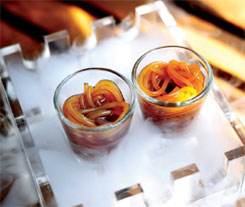 Restaurants are trying to attract customers using molecular gastronomy, but it may not be so easy to please the picky Indian Palate, says VIDYA DESHPANDE
Restaurants are trying to attract customers using molecular gastronomy, but it may not be so easy to please the picky Indian Palate, says VIDYA DESHPANDE
Has the Indian palate experimented enough to enjoy the subtleties of molecular gastronomy? I will answer that question last. First, let’s see where this trend has reached in India. Not many knew of molecular gastronomy in the country until the advent of the popular TV series MasterChef Australia. It had episodes with renowned chef Heston Blumenthal, who brought the lab into the kitchen and introduced the art of molecular gastronomy to Indian homes.
Molecular gastronomy combines chemistry and food to give you an elevated dining experience. With this science, you can enhance the flavours, textures and aromas, turning a simple dish into an exotic variation. Take, for instance, the humble mishti doi, a popular Bengali dessert. Zoravar Kalra, the man behind Farzi Café in Gurgaon’s Cyber Hub, has turned this into a striking appetiser. A dollop of mishti doi is injected into a diaphanous covering with a spot of jam on top, to make it look like an eyeball. The dish is served on a platter of liquid nitrogen. It’s a dish you eat with your eyes, taste buds and sense of smell. The perky presentation adds to the eye appeal, while your taste buds savour the flavour of the sweetened curd that melts in your mouth in seconds. The dish is served at the beginning of your meal, works as an appetiser as well as a palate cleanser.
According to Chef Blumenthal, this technique was first introduced in 1991. “Since then, it has become a convenient, catch-all-phrase to describe science-driven cooking. It explains little and misleads a lot,” he explains in a cooking statement on his website. The chef also feels the term has become “fashionable” and doesn’t describe his style of cooking. But one has to admit that the advent of using chemistry in the kitchen has certainly changed the way one looks at a dish.
Instant ice cream parlours have popped up all over the country, where liquid nitrogen is used to instantly freeze a concoction, and served to you even as you choose the flavours, colours and textures. Like Nice Ice in Hauz Khas Village in Delhi. You can choose the colour, texture and flavour of the ice cream you create. So, one can opt for a chocolate flavoured ice cream that is green or purple in colour, depending on your mood. Who says chocolate ice cream has to be only dark brown in colour?
Using molecular gastronomy allows the chefs to serve a bit of trickery on your table as they can present dishes that add a twist to the flavours, with drama added to the presentation to make your dining experience more fun. You can have cocktails inside spheres of ice, ravioli made from translucent covering instead of the conventional flour dough, or caviar made of olive oil droplets. It’s this “wow” element that attracts people to molecular gastronomy dishes.
Run by Chef Abhijit Saha, Fava in Bengaluru is popular for dishes cooked using molecular gastronomy. Saha’s most popular dish is a sous vide, where vacuumpacked meat is cooked in a water bath. The meat retains it pink colour and natural juice even as it gets cooked to perfection.
The concept of molecular gastronomy is fairly nascent in India and not many restaurants have taken to this science. It is more popular with young chefs and in restaurants that have experimental menus and thus the demand for such dishes is relatively low as of now. While in the west, Chefs such as Blumenthal and others are moving on from molecular gastronomy, Indian chefs are still in the experimental stage of this technique. It is only bigger cities such as Delhi, Mumbai and Bengaluru that are open to such experimentation, while most prefer to stick to traditional dishes in other cities.
Molecular gastronomy also provides the options of using natural, vegetarian ingredients to create tastes and flavours that are mainly nonvegetarian. Like a jackfruit kebab, which can be granulised using molecular gastronomy to taste and look like a mutton kebab. However, the concept itself is so alien to the Indian palate that it would be difficult to get picky Indian customers to accept this.
Which brings me back to the question I first raised. The Indian palate may not readily accept experimentations with food. People may like the dramatic presentations but how long the fad will last is anybody’s guess.
